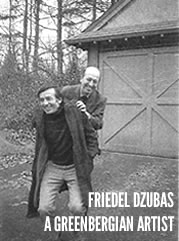 |
 |
Dzubas a Greenbergian artist Friedel Dzubas met Clement Greenberg in 1948, when the formal critic rented a building on the painter’s Connecticut property for the summer. Dzubas had the opportunity to share the place in Redding with the formalist art critic whose articles he had long been reading. Dzubas said about him: A lifelong relationship began, and on the one hand it was the fortune of Dzubas, since he was introduced to the New York School and major abstract expressionists - he even arranged for him to share a studio with Helen Frankenthaler in the early 50s. On the other hand this relationship filled the painter with doubts about his talent, always in search of an approval by Greenberg, since in his works he refused to completely apply to Greenbergian aesthetic canons. Part of the problem was that Dzubas at that time started really worshipping the work of Klee,2 and Clement Greenberg really disapproved of that considering Klee just a “small Master.”3 Nevertheless, on April 23, 1964 Dzubas was included in the Post Painterly Exhibition opening in Los Angeles County Museum of Art cured by Clement Greenberg, who labeled the work of the artists in the show as “an authentically new episode in the evolution of contemporary art.”4 According to Greenberg, the new art presented in the exhibition was a reaction against standardization of the second generation of Abstract Expressionists,5 and the 31 artists picked to represent a new art where in a way “moving towards a physical openness of design, or towards linear clarity, or towards both.”6
Art historian Barbara Rose writes in Reconsidering Friedel Dzubas that the friendship with Clement Greenberg immediately pulled Dzubas in the heart of the New York School, but at the same time it led to a complete misunderstanding of his own objectives and aesthetic, by placing him within the category of stained Color Field painters, which was not where he belonged. He was judged by the wrong criteria whereas his paintings belong much more to a second-generation Abstract Expressionists drawn by a more metaphorical language.11 On his own relationship with Greenberg, Dzubas said that he approved of his activities and disapproved in specific pictures, but most importantly he made him aware of the American scene.12 1 Barbara Rose, Reconsidering Friedel Dzubas, (West Palm Beach, FL: Eaton Fine Art, Inc, 2009), 12. 2 Ibid., 13. 3 Ibid., 14. 4 Clement. Greenberg, Post Painterly Abstraction, exh. cat. (Los Angeles: Printed by the F. Hensen Co., 1964), 4. 5 Clement Greenberg, Post Painterly Abstraction, (Los Angeles: Printed by the F. Hensen Co., 1964), 2, identified the most conspicuous of Abstract Expressionist mannerism as the “Tenth Street Touch,” which was characterized by “the stroke left by a loaded brush or knife fraying out into streak, ripples and specks of paint, that create variation of light and dark by means of which juxtaposed strokes can be graded into one another without abrupt contrasts. What tuned this constellation of stylistic features into something bad as art was its standardization, its reduction to a set of mannerisms, as a dozen, and with the same gestures, into the same kind of picture. So nice to see someone making use of annotated footnotes! 6 Greenberg, Post Painterly Abstraction, 1964, 3. 7 Millard, 1983, 28. 8 Timothy McElreavy, “Language Barriers, Critical and Painterly Semantic and the Work of Friedel Dzubas,” in Friedel Dzubas Critical Painting, (Tuft University, 1998): 39. 9 Ibid., 40. 10 Barbara Rose, 2009, 14. 11 Millard, 1983, 25. 12 Ibid., 24. |
 Figure 1, Friedel Dzubas, Between, 1963, oil on canvas, 89” x 62", Collection of Andre' Elkon.
Figure 1, Friedel Dzubas, Between, 1963, oil on canvas, 89” x 62", Collection of Andre' Elkon.